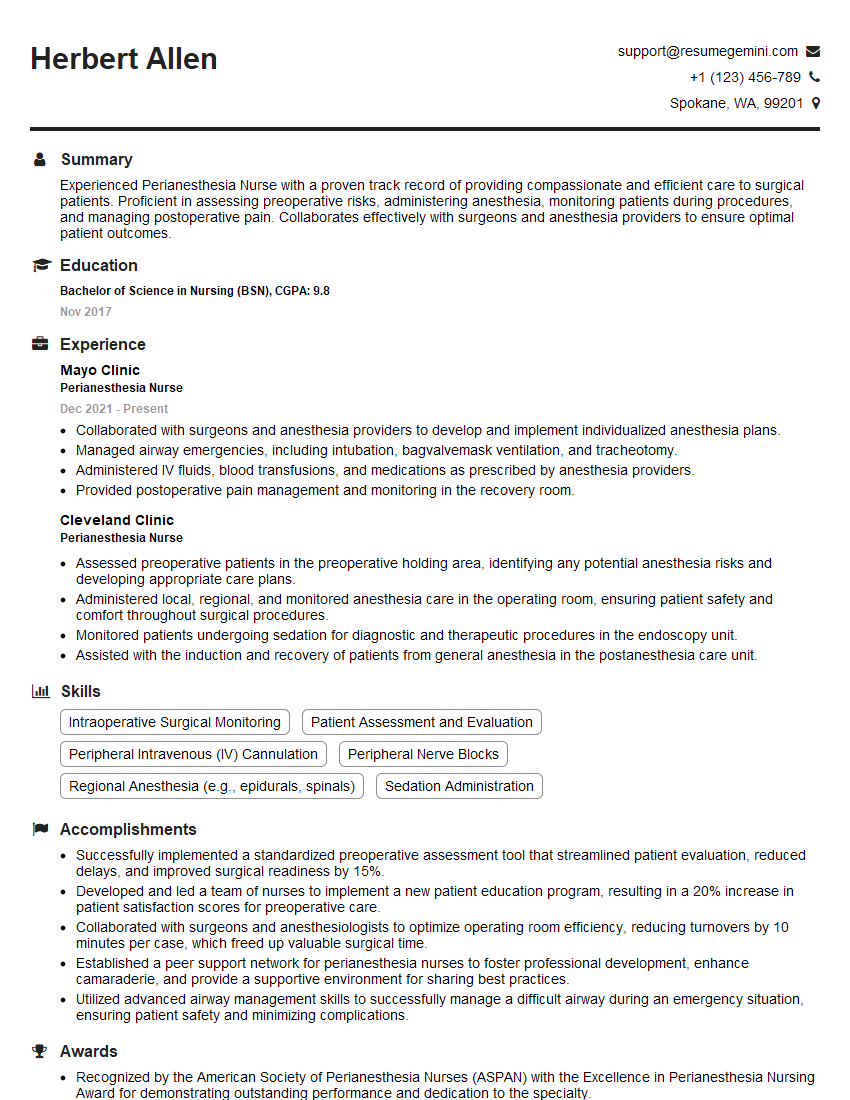Are you a seasoned Perianesthesia Nurse seeking a new career path? Discover our professionally built Perianesthesia Nurse Resume Template. This time-saving tool provides a solid foundation for your job search. Simply click “Edit Resume” to customize it with your unique experiences and achievements. Customize fonts and colors to match your personal style and increase your chances of landing your dream job. Explore more Resume Templates for additional options.

Herbert Allen
Perianesthesia Nurse
Summary
Experienced Perianesthesia Nurse with a proven track record of providing compassionate and efficient care to surgical patients. Proficient in assessing preoperative risks, administering anesthesia, monitoring patients during procedures, and managing postoperative pain. Collaborates effectively with surgeons and anesthesia providers to ensure optimal patient outcomes.
Education
Bachelor of Science in Nursing (BSN)
November 2017
Skills
- Intraoperative Surgical Monitoring
- Patient Assessment and Evaluation
- Peripheral Intravenous (IV) Cannulation
- Peripheral Nerve Blocks
- Regional Anesthesia (e.g., epidurals, spinals)
- Sedation Administration
Work Experience
Perianesthesia Nurse
- Collaborated with surgeons and anesthesia providers to develop and implement individualized anesthesia plans.
- Managed airway emergencies, including intubation, bagvalvemask ventilation, and tracheotomy.
- Administered IV fluids, blood transfusions, and medications as prescribed by anesthesia providers.
- Provided postoperative pain management and monitoring in the recovery room.
Perianesthesia Nurse
- Assessed preoperative patients in the preoperative holding area, identifying any potential anesthesia risks and developing appropriate care plans.
- Administered local, regional, and monitored anesthesia care in the operating room, ensuring patient safety and comfort throughout surgical procedures.
- Monitored patients undergoing sedation for diagnostic and therapeutic procedures in the endoscopy unit.
- Assisted with the induction and recovery of patients from general anesthesia in the postanesthesia care unit.
Accomplishments
- Successfully implemented a standardized preoperative assessment tool that streamlined patient evaluation, reduced delays, and improved surgical readiness by 15%.
- Developed and led a team of nurses to implement a new patient education program, resulting in a 20% increase in patient satisfaction scores for preoperative care.
- Collaborated with surgeons and anesthesiologists to optimize operating room efficiency, reducing turnovers by 10 minutes per case, which freed up valuable surgical time.
- Established a peer support network for perianesthesia nurses to foster professional development, enhance camaraderie, and provide a supportive environment for sharing best practices.
- Utilized advanced airway management skills to successfully manage a difficult airway during an emergency situation, ensuring patient safety and minimizing complications.
Awards
- Recognized by the American Society of Perianesthesia Nurses (ASPAN) with the Excellence in Perianesthesia Nursing Award for demonstrating outstanding performance and dedication to the specialty.
- Received the Hospitals Nurse of the Year Award for consistently exceeding expectations in providing exceptional patient care and contributing to the advancement of perianesthesia nursing practices.
- Honored with the Perianesthesia Nurse Excellence Award by the local nursing association for significant contributions to the field and mentorship of junior nurses.
- Recognized by the National Board of Certification and Recertification of Nurse Anesthetists (NBCRNA) with the Certified Registered Nurse Anesthetist (CRNA) credential, demonstrating expertise in the administration of anesthesia.
Certificates
- Certified Perioperative Nurse (CNOR)
- Certified Registered Nurse Anesthetist (CRNA)
- Certified Nurse Specialist in Perianesthesia Nursing (CNS-PAN)
- Post-Anesthesia Care Nurse (PACN)
Career Expert Tips:
- Select the ideal resume template to showcase your professional experience effectively.
- Master the art of resume writing to highlight your unique qualifications and achievements.
- Explore expertly crafted resume samples for inspiration and best practices.
- Build your best resume for free this new year with ResumeGemini. Enjoy exclusive discounts on ATS optimized resume templates.
How To Write Resume For Perianesthesia Nurse
- Highlight your experience in administering various types of anesthesia, including general, regional, and local.
- Quantify your accomplishments whenever possible, using specific numbers and metrics.
- Emphasize your ability to work independently and as part of a team in a fast-paced environment.
- Showcase your knowledge of anesthesia pharmacology, physiology, and equipment.
- Include any certifications or continuing education courses that demonstrate your commitment to professional development.
Essential Experience Highlights for a Strong Perianesthesia Nurse Resume
- Assessed preoperative patients, identifying potential anesthesia risks and developing care plans.
- Administered local, regional, and general anesthesia, ensuring patient safety and comfort.
- Monitored patients undergoing sedation for diagnostic and therapeutic procedures.
- Assisted with induction and recovery from general anesthesia.
- Collaborated with surgeons and anesthesia providers to develop individualized anesthesia plans.
- Managed airway emergencies, including intubation, bag-valve-mask ventilation, and tracheotomy.
Frequently Asked Questions (FAQ’s) For Perianesthesia Nurse
What are the primary responsibilities of a Perianesthesia Nurse?
Perianesthesia Nurses are responsible for assessing preoperative patients, administering anesthesia, monitoring patients during procedures, and managing postoperative pain. They work closely with surgeons and anesthesia providers to ensure the safety and comfort of surgical patients.
What are the educational requirements to become a Perianesthesia Nurse?
Most Perianesthesia Nurses hold a Bachelor of Science in Nursing (BSN) degree. Some employers may also require additional training or certification in perianesthesia nursing.
What are the career advancement opportunities for Perianesthesia Nurses?
Perianesthesia Nurses can advance their careers by specializing in a particular area of anesthesia, such as cardiac anesthesia or pediatric anesthesia. They can also move into management or education roles.
What are the challenges of working as a Perianesthesia Nurse?
Perianesthesia Nurses work in a fast-paced and demanding environment. They must be able to think critically and make quick decisions. They must also be able to work well under pressure and remain calm in emergency situations.
What are the rewards of working as a Perianesthesia Nurse?
Perianesthesia Nurses play a vital role in the surgical team. They have the opportunity to make a real difference in the lives of patients. They also enjoy a high level of job satisfaction and earning potential.